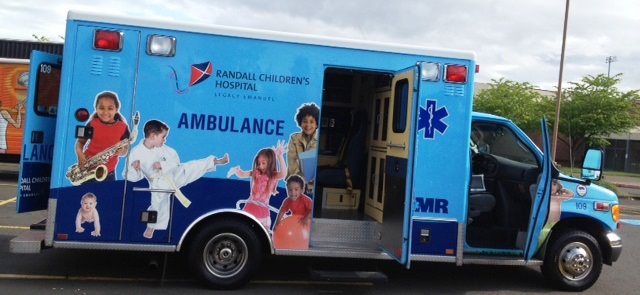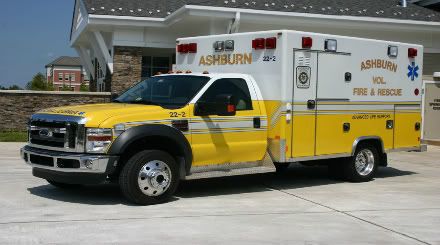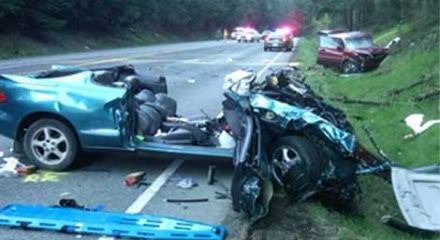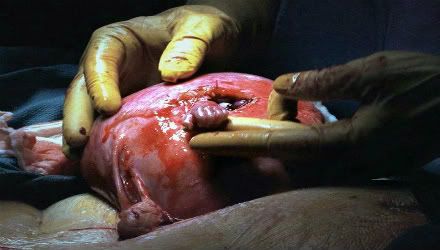New Move To Hands Only CPR
Sure AHA changes the CPR rules every 30 seconds, but this is a welcome change that will stay around a while probably
Professionalism Is Key
Take care to maintain professionalism to the public! You get one shot at the first impression and that impression makes your patient have more confidence in your ability!
Can You Change Death?
Have you really thought about a crash this severe and if how you would handle things if you were first to arrive on scene? If you fall back on your training...is that training good enough to change death to life?
Take Pride in Your Education
Your education in EMS will not only land you a good job but it could save someone's life! You owe it to your patient to be prepared! It's your future but it's their lives!
Monday, February 27, 2017
CITY SEES OVERDOSE SURGE, MULTIPLE DEATHS
A surge in overdoses has Hamilton County Heroin Coalition on alert.
Hamilton County Commissioner Denise Driehaus, chair of the coalition, this morning announced a news conference to discuss a spike in overdose deaths that occurred over the weekend and overdoses during the month of February. The coroner's office, public health officials, and law enforcement will attend the press conference, which is scheduled for 1:15 p.m. at the Hamilton County Public Health offices.
Officials on Sunday night said there were multiple overdoses over the weekend.
"We've been monitoring this afternoon and tonight," said Newtown Police Chief Tom Synan, director of the law enforcement task force for the coalition.
Emergency medical services and police records of overdose runs have jumped, Synan said, adding, "We have also seen more than normal deaths for the month."
The total numbers were not definite as of Sunday night, Synan said because there were some inconsistencies in the count.
Hamilton County Coroner Dr. Lakshmi Sammarco confirmed, "We have had multiple" overdose deaths. She could not immediately be more specific.
Synan said it is premature to say just what has caused the irregularities or to call the situation an emergency.
He said there were four "possible overdose deaths" on Sunday in the Cincinnati Police District 3, "and a possible two more potential overdose deaths (elsewhere) in the city."
The police district 3 is on the West Side of Cincinnati, which experienced the bulk of a torrent of overdoses over the summer and through early fall in Hamilton County and Northern Kentucky.
Synan said the coalition has been fervent about monitoring the overdoses in the area since the late summer, early fall spike in overdoses. Then, the city encountered hundreds of overdoses from August through October, after finding the elephant opioid carfentanil in the heroin stream in July in Hamilton County.
He said it was premature to discuss what drug was causing the current surge: "It could be heroin, fentanyl, carfentanil, (fentanyl) derivatives or none of the above."
Coalition team members hoped to have additional information Monday. Terry DeMio tdemio@enquirer.com
Tuesday, February 21, 2017
Canada's Spectral hoping to win U.S. approval for sepsis treatment
A small Canadian drugmaker is in the final stages of testing technology designed to treat sepsis, the surprisingly common condition that killed boxing legend, Muhammad Ali.
If data from the late-stage trial is positive, Spectral Medical Inc thinks it can win approval from the U.S. Food and Drug Administration as early as next year.
The technology has been in use in Japan and parts of Europe for years but has never been approved for wide use in the United States because, in the view of the FDA, it has never been tested in trial large enough to prove its effectiveness and safety.
Sepsis, derived from the Greek word for putrefaction, occurs when the immune system goes into overdrive to fight infection or bacterial toxins, triggering a cascade of physiological changes that can lead to multiple organ failure.
The leading cause of hospitalizations in the United States, it can result from a simple cut, routine surgery or infections associated with chronic disease - Parkinson's, in Ali's case.
Sepsis costs the U.S. healthcare system about $20 billion a year, according to the Sepsis Alliance, a San Diego-based patient advocacy organization.
Infants, the elderly and those with weakened immune systems are most at risk.
In extreme cases, a dramatic drop in blood pressure can lead to life-threatening septic shock.
This is where Spectral comes in.
The Toronto company holds North American rights to a system developed by Japan's Toray Industries Inc designed to restore blood pressure and correct organ dysfunction by using an antibiotic to detoxify the blood.
ALSO IN HEALTH NEWS
Once the patient's blood has been extracted it is passed through a column to remove a type of toxin, called an endotoxin, which is believed to be a major trigger for sepsis.
The system allows you to "take the blood, clean the blood and return the blood," said Dr. Claudio Ronco, an Italian kidney specialist who has used the system extensively for more than two decades in the field.
Ronco said he has no financial ties to Spectral and has received only honorariums for speaking about his experience with the treatment at industry-sponsored symposiums embedded in scientific meetings, once by Toray.
"Even if the trial in the United States is not positive ... I will treat my patients with this device because we have seen it works," he added.
EFFECTIVENESS CONCERNS
Toray has been selling the Toraymyxin system in its home market since 1994 and through distributors in Europe since 2002. The system is also approved for use in Canada.
Still, data supporting the use of the device is intensely debated, with trials conducted outside of Japan and Italy failing to prove its effectiveness, Cormark Securities analyst David Novak wrote in a research note last month.
Spectral Chief Executive Paul Walker told Reuters that a lack of major recognized clinical trials that proved efficacy beyond question had "definitely slowed adoption."
The company's late-stage U.S. data is expected by September.
In the meantime, the FDA has approved the "compassionate use" of the product in select hospitals.
To accompany the device, Spectral has created a diagnostic test that can determine whether a patient has high endotoxin levels. The FDA cleared the test in 2003 and it has been approved elsewhere since then.
About 68 percent of patients with Ali's condition - those that develop septic shock - have high endotoxin levels, said Walker, a medical doctor, and co-inventor of the test.
There are no specific FDA-approved medicines for the treatment of sepsis, and there have been several high-profile clinical failures.
The only drug to win FDA endorsement - Eli Lilly & Co's Xigris - was pulled off the market in 2011, a decade after approval, when follow-up clinical trials showed its use did not reduce mortality.
The U.S. Centers for Disease Control and Prevention estimates that up to half of the estimated 1 million annual cases of sepsis in the United States result in death.
Every year, about 350,000 patients in North America are diagnosed with septic shock. Even a 15 percent cut in the mortality rate would be sufficient to justify an estimated $20,000 price tag per treatment, Walker said.
Spectral - which has a market value of about $160 million but generated just $3.08 million in revenue in 2015 - hopes to capture about half of the estimated $3 billion market within five years of FDA approval, he said.
If approved, Cormark's Novak expects the product to achieve peak annual sales of more than $800 million.
(Reporting by Natalie Grover in Bengaluru; Additional reporting by Amrutha Penumudi; Editing by Robin Paxton and Ted Kerr) For the full story ... From Reuters
Thursday, February 16, 2017
Signs and symptoms of PTSD
The symptoms of post-traumatic stress disorder (PTSD) can arise suddenly, gradually, or come and go over time. Sometimes symptoms appear seemingly out of the blue. At other times, they are triggered by something that reminds you of the original traumatic event, such as a noise, an image, certain words, or a smell.
While everyone experiences PTSD differently, there are three main types of symptoms:
Re-experiencing the traumatic event
Avoiding reminders of the trauma
Increased anxiety and emotional arousal
Symptoms of PTSD:
Re-experiencing the traumatic event
Intrusive, upsetting memories of the event
Flashbacks (acting or feeling like the event is happening again)
Nightmares (either of the event or of other frightening things)
Feelings of intense distress when reminded of the trauma
Intense physical reactions to reminders of the event (e.g. pounding heart, rapid breathing, nausea, muscle tension, sweating)
Symptoms of PTSD: Avoidance and numbing
Avoiding activities, places, thoughts, or feelings that remind you of the trauma
Inability to remember important aspects of the trauma
Loss of interest in activities and life in general
Feeling detached from others and emotionally numb
Sense of a limited future (you don’t expect to live a normal life span, get married, have a career)
Symptoms of PTSD: Increased anxiety and emotional arousal
Difficulty falling or staying asleep
Irritability or outbursts of anger
Difficulty concentrating
Hypervigilance (on constant “red alert”)
Feeling jumpy and easily startled
Other common symptoms of post-traumatic stress disorder (PTSD)
Anger and irritability
Guilt, shame, or self-blame
Feelings of mistrust and betrayal
Depression and hopelessness
Suicidal thoughts and feelings
Feeling alienated and alone
Physical aches and pains
Symptoms of PTSD in children and adolescents
In children—especially those who are very young—the symptoms of PTSD can be different than the symptoms in adults. Symptoms in children include:
Fear of being separated from parent
Losing previously-acquired skills (such as toilet training)
Sleep problems and nightmares without recognizable content
Somber, compulsive play in which themes or aspects of the trauma are repeated
New phobias and anxieties that seem unrelated to the trauma (such as a fear of monsters)
Acting out the trauma through play, stories, or drawings
Aches and pains with no apparent cause
Irritability and aggression
Post-traumatic stress disorder (PTSD) causes and risk factors
While it’s impossible to predict who will develop PTSD in response to trauma, there are certain risk factors that increase your vulnerability.
Many risk factors revolve around the nature of the traumatic event itself. Traumatic events are more likely to cause PTSD when they involve a severe threat to your life or personal safety: the more extreme and prolonged the threat, the greater the risk of developing PTSD in response. Intentional, human-inflicted harm—such as rape, assault, and torture— also tends to be more traumatic than “acts of God” or more impersonal accidents and disasters. The extent to which the traumatic event was unexpected, uncontrollable, and inescapable also plays a role.
Other risk factors for PTSD include:
Previous traumatic experiences, especially in early life
Family history of PTSD or depression
History of physical or sexual abuse
History of substance abuse
History of depression, anxiety, or another mental illness
High level of stress in everyday life
Lack of support after the trauma
Lack of coping skills
Getting help for post-traumatic stress disorder (PTSD)
If you suspect that you or a loved one has post-traumatic stress disorder (PTSD), it’s important to seek help right away. The sooner PTSD is confronted, the easier it is to overcome. If you’re reluctant to seek help, keep in mind that PTSD is not a sign of weakness, and the only way to overcome it is to confront what happened to you and learn to accept it as a part of your past. This process is much easier with the guidance and support of an experienced therapist or doctor.
It’s only natural to want to avoid painful memories and feelings. But if you try to numb yourself and push your memories away, post-traumatic stress disorder (PTSD) will only get worse. You can’t escape your emotions completely—they emerge under stress or whenever you let down your guard—and trying to do so is exhausting. The avoidance will ultimately harm your relationships, your ability to function, and the quality of your life.
Students gain experience in EMT course
Many college students pick up part time work wherever they can, and most of the time it’s not very exciting or glamorous. Chippewa Falls High School senior Lindsey Nelson has a different plan.
“I will definitely work as an EMT,” Nelson said. “I plan on going to college in Milwaukee and they always need EMTs there. I can work part-time while in school and full-time in the summer."
Nelson is working toward an EMT (Emergency Medical Technician) license through a class at Chippewa Valley Technical College’s Emergency Services Education Center in Eau Claire. She is one of 19 high school seniors from Chippewa Falls, Bloomer, Eau Claire and Fall Creek high schools enrolled in the class, which meets Tuesday nights and one Saturday a month.
“This is an EMT basic class for the state of Wisconsin,” CVTC instructor Kassondra Mero said. “When they finish, they will be able to get a state license as a basic EMT and by finishing the class they can take the national EMT registry exam.”
The class was made possible by a $111,000 Wisconsin Fast Forward Blueprint for Prosperity High School Pupil Workforce Training Programs grant. It is part of a larger statewide effort to engage high school students in college-level classes to increase their college success rate. The program also provides them with industry-recognized certificates that increase their employment prospects.
“By becoming licensed EMTs, they will be eligible to be hired for jobs that pay $35,000 a year,” Mero said.
Students in Mero’s class, though, are thinking bigger and longer-term.
“All of the students in the class have expressed an interest in careers in health care,” Mero said. “They have an understanding of how this is going to impact their careers. This puts them leaps and bounds ahead of others because they will be able to get real life experience at the age of 18.”
Some participating students want to be firefighters or paramedics; others want to be doctors or nurses, said Chris McHenry, CVTC Emergency Medical Services program director. “They don’t have to wait until after they graduate to be introduced to the profession,” he said.
‘Cool opportunity’
Nelson hopes the program leads to bigger and better things.
“I thought this would be a cool opportunity to see what I wanted to do when I got older,” said Nelson, who plans to attend UW-Milwaukee and to become a physician’s assistant. “Now that I’ve taken this class, I’m pretty sure I want to go into the medical field.”
Musselman said he feels the class has done him good whether he ever works as an EMT or not.
“It gives me the skills I need if an emergency comes up,” he said.
The class provides credit toward students’ high school graduation and earns them five credits at CVTC. Those credits are transferrable to other colleges with which CVTC has agreements.
Hard work
Participating students learn that the chance to get a jump on their careers doesn’t come easily. Mero said the first hour of the class typically consists of teacher-led instruction, followed by two hours of hands-on work in which students practice various scenarios. The knowledge level needed for EMT work is significant, she said.
“When you get to medical emergencies and the pharmacology, you have to memorize all of that, along with the doses and effects,” Mero said. “At test time, they get a blank piece of paper and they have to write down all they know about that medication.”
Students in the class are used to college-level work through other CVTC dual-credit classes and advanced placement courses.
“It’s time-consuming and rather hard, but it’s a lot like medical terminology,” said Musselman, referring to a college-level class many high school students take.
Real situations
Students said they are well aware that someday it will not be a medical mannequin or a fellow student playing a patient, but a real situation in which someone is facing a medical crisis. They are preparing for such instances.
“I think I’m ready for it,” Nelson said. “I saw a basketball player tear up a knee and it was a wake-up call, having to respond to someone in pain. But I’ll be ready for it.”
McHenry noted that the class benefits the community as well, as many students will work as EMTs in their home towns, at least for a time.
“Across the state, we are seeing a lack of volunteers, especially the ability to fill needs at volunteer services in smaller communities,” McHenry said. “The state has been looking for ways like this to increase volunteerism in communities.”
The class goes through May 2017. McHenry said plans are being made to continue it in future years.
For the initial story CLICK HERE






























